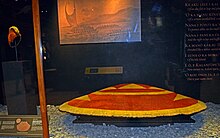Kalaniʻōpuʻu: Difference between revisions
Content deleted Content added
Bluelink 2 books for verifiability. [goog]) #IABot (v2.0) (GreenC bot |
|||
| Line 18: | Line 18: | ||
'''Kalani{{okina}}ōpu{{okina}}u-a-Kaiamamao''' (c. 1729 – April 1782) was the [[aliʻi|aliʻi nui]] (supreme monarch) of the [[Hawaii (island)|island of Hawaiʻi]]. He was called ''Terreeoboo, King of Owhyhee'' by James Cook and other Europeans. His name has also been written as Kaleiopuu. |
'''Kalani{{okina}}ōpu{{okina}}u-a-Kaiamamao''' (c. 1729 – April 1782) was the [[aliʻi|aliʻi nui]] (supreme monarch) of the [[Hawaii (island)|island of Hawaiʻi]]. He was called ''Terreeoboo, King of Owhyhee'' by James Cook and other Europeans. His name has also been written as Kaleiopuu. |
||
HI |
|||
==Biography== |
|||
Kalaniʻōpuʻu was the son of [[Kalaninuiamamao]] (k) and his wife [[Kamakaimoku|Kamākaʻimoku]] (w), a high ranking aliʻi wahine (female of hereditary nobility) who was also the mother of [[Keōua]] (k) with another husband named [[Kalanikeʻeaumoku]] (k). This made her the grandmother of [[Kamehameha I]].<ref name="Fornander1880" /> During his reign, [[Alapainui]] had kept the two young princes, Kalaniʻōpuʻu and Keōua, close to him out of either kindness or politics.<ref name="Fornander1880">{{cite book|author=Abraham Fornander|title=An Account of the Polynesian Race: Its Origins and Migrations, and the Ancient History of the Hawaiian People to the Times of Kamehameha I.|url=https://archive.org/details/bub_gb_tcQNAAAAQAAJ|year=1880|publisher=Trubner & Company|page=[https://archive.org/details/bub_gb_tcQNAAAAQAAJ/page/n149 135]}}</ref><ref name="Society1904">{{cite book|author=Hawaiian Historical Society|title=Annual Report of the Hawaiian Historical Society|url=https://books.google.com/books?id=jlVFAAAAYAAJ&pg=RA4-PA7|year=1904|publisher=The Society|page=7}}</ref> |
|||
Kalani{{okina}}ōpu{{okina}}u-a-Kaiamamao was the king of the island during the times [[Captain James Cook]] came to Hawaiʻi and went aboard his ship on 26 November 1778.<ref>{{cite book | author=William De Witt Alexander |year=1891 |title=A brief history of the Hawaiian people |publisher=American Book Co. |url=https://archive.org/details/bub_gb_Fds3JhdHlnsC |pages=[https://archive.org/details/bub_gb_Fds3JhdHlnsC/page/n111 104]–116}}</ref> After Cook anchored at [[Kealakekua Bay]] in January 1779, Kalani{{okina}}ōpu{{okina}}u-a-Kaiamamao paid a ceremonial visit on 26 January 1779 and exchanged gifts including a [[ʻahuʻula]] (feathered cloak)<ref>{{cite web |url=http://collections.tepapa.govt.nz/objectdetails.aspx?oid=230439 |title='ahu 'ula (Feathered cloak) |publisher=Museum of [[New Zealand]] web site |accessdate=2009-07-19 }}</ref> and [[mahiole]] (ceremonial helmet),<ref>{{cite web |url=http://collections.tepapa.govt.nz/objectdetails.aspx?oid=230445 |title=Mahiole (helmet) |publisher=Museum of New Zealand web site |accessdate=2009-07-19 }}</ref> since it was during the [[Makahiki]] season. Cook's ships returned on 11 February to repair storm damage. This time relations were not as good, resulting in [[Kidnapping of Kalaniʻōpuʻu by Captain James Cook|a violent struggle]] when Cook tried to take Kalaniʻōpuʻu hostage after the theft of a longboat, which led to [[James_Cook#Death|Cook's death]]. |
|||
Kalani{{okina}}ōpu{{okina}}u-a-Kaiamamao died at Kāʻilikiʻi, Waioʻahukini, Kaʻū, in April 1782. He was succeeded by his son, [[Kīwalaʻō]], as king of Hawai{{okina}}i island; and his nephew, [[Kamehameha I]], who was given guardianship of [[Kū|Kū-ka-ili-moku]], the god of war. His nephew would eventually overthrow his son at the [[Battle of Moku'ohai|battle of Moku{{okina}}ōhai]]. The island of Hawai{{okina}}i was then effectively divided into three parts: his nephew Kamehameha ruled the western districts, his younger son [[Keōua Kuahuula]] controlled Ka{{okina}}ū, and his brother Keawemauhili controlled [[Hilo]]. |
|||
{{Kalaniʻōpuʻu, Kamehameha, Kānekapōlei and Peleuli family tree}} |
|||
[[File:Kalaniopuu cape.jpg|thumb|A feathered cloak associated with Kalaniʻōpuʻu, on display at the [[de Young Museum]] in [[San Francisco]]]] |
|||
== See also == |
== See also == |
||
Revision as of 03:43, 30 April 2020
| Kalaniʻōpuʻu-a-Kaiamamao | |
|---|---|
| Aliʻi Nui of Kaʻū Aliʻi Aimoku of Hawaiʻi | |
 | |
| Born | c. 1729 |
| Died | April 1782 (aged 52–53) Kāʻilikiʻi, WaioʻahukiniKaʻū |
| Spouse | Kalola Pupuka-o-Honokawailani Kalaiwahineuli Kamakolunuiokalani Mulehu Kānekapōlei Kekupuohi[1] |
| Issue | Kīwalaʻō Kalaipaihala Pualinui Keōua Kuahuʻula Keōua Peʻeale |
| House | House of Keawe |
| Father | Kalaninuiamamao |
| Mother | Kamakaimoku |
Kalaniʻōpuʻu-a-Kaiamamao (c. 1729 – April 1782) was the aliʻi nui (supreme monarch) of the island of Hawaiʻi. He was called Terreeoboo, King of Owhyhee by James Cook and other Europeans. His name has also been written as Kaleiopuu.
HI
